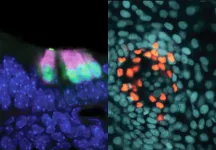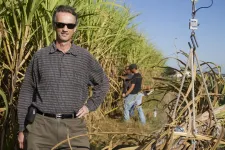(Press-News.org) Los Alamos, N.M., July 12, 2021--For the first time, the long-theorized neutron-clustering effect in nuclear reactors has been demonstrated, which could improve reactor safety and create more accurate simulations, according to a new study recently published in the journal Nature Communications Physics.
"The neutron-clustering phenomenon had been theorized for years, but it had never been analyzed in a working reactor," said Nicholas Thompson, an engineer with the Los Alamos Advanced Nuclear Technology Group. "The findings indicate that, as neutrons fission and create more neutrons, some go on to form large lineages of clusters while others quickly die off, resulting in so-called 'power tilts,' or asymmetrical energy production."
Understanding these clustering fluctuations is especially important for safety and simulation accuracy, particularly as nuclear reactors first begin to power up. The study was a collaboration with the Institute for Radiological Protection and Nuclear Safety (IRSN) and the Atomic Energy Commission (CEA), both located in France.
"We were able to model the life of each neutron in the nuclear reactor, basically building a family tree for each," said Thompson. "What we saw is that even if the reactor is perfectly critical, so the number of fissions from one generation to the next is even, there can be bursts of clusters that form and others that quickly die off."
This clustering phenomenon became important to understand because of a statistical concept known as the gambler's ruin, believed to have been derived by Blaise Pascal. In a betting analogy, the concept says that even if the chances of a gambler winning or losing each individual bet are 50 percent, over the course of enough bets the statistical certainty that the gambler will go bankrupt is 100 percent.
In nuclear reactors, from generation to generation, each neutron can be said to have a similar 50 percent chance of dying or fissioning to create more neutrons. According to the gambler's ruin concept, the neutrons in a reactor might then have a statistical chance of dying off completely at some future generation, even though the system is at critical.
This concept had been studied widely in other scientific fields, such as biology and epidemiology, where this generational clustering phenomenon is also present. By drawing on this related statistical math, the research team was able to analyze whether the gambler's ruin concept would hold true for neutrons in nuclear reactors.
"You would expect this theory to hold true," says Jesson Hutchinson, who works with the Laboratory's Advanced Nuclear Technology Group. "You should have a critical system that, while the neutron population is varying between generations, runs some chance of becoming subcritical and losing all neutrons. But that's not what happens."
To understand why the gambler's ruin concept didn't hold true, researchers used a low-power nuclear reactor located at the Walthousen Reactor Critical Facility in New York. A low-power reactor was essential for tracking the lifespans of individual neutrons because large-scale reactors can have trillions of interactions at any moment. The team used three different neutron detectors, including the Los Alamos-developed Neutron Multiplicity 3He Array Detector (NoMAD), to trace every interaction inside the reactor.
The team found that while generations of neutrons would cluster in large family trees and others died out, a complete die-off was avoided in the small reactor because of spontaneous fission, or the non-induced nuclear splitting of radioactive material inside reactors, which creates more neutrons. That balance of fission and spontaneous fission prevented the neutron population from dying out completely, and it also tended to smooth out the energy bursts created by clustering neutrons.
"Commercial-sized nuclear reactors don't depend on the neutron population alone to reach criticality, because they have other interventions like temperature and control rod settings," Hutchinson said. "But this test was interested in answering fundamental questions about neutron behavior in reactors, and the results will have an impact on the math we use to simulate reactors and could even affect future design and safety procedures."
INFORMATION:
Funding: This work was supported by the DOE Nuclear Criticality Safety Program, funded and managed by the National Nuclear Security Administration for the Department of Energy.
Paper: Dumonteil, E., Bahran, R., Cutler, T. et al. Patchy nuclear chain reactions. Nature Communications Physics. 01 July 2021
DOI: https://doi.org/10.1038/s42005-021-00654-9
About Los Alamos National Laboratory
Los Alamos National Laboratory, a multidisciplinary research institution engaged in strategic science on behalf of national security, is managed by Triad, a public service oriented, national security science organization equally owned by its three founding members: Battelle Memorial Institute (Battelle), the Texas A&M University System (TAMUS), and the Regents of the University of California (UC) for the Department of Energy's National Nuclear Security Administration.
Los Alamos enhances national security by ensuring the safety and reliability of the U.S. nuclear stockpile, developing technologies to reduce threats from weapons of mass destruction, and solving problems related to energy, environment, infrastructure, health, and global security concerns.
(Boston)--Despite the availability of numerous effective birth control methods, more than 40 percent of pregnancies worldwide are unintended. In addition to contributing significantly to population growth, unintended pregnancies can have pronounced adverse effects on maternal physical, mental and economic wellbeing.
Researchers from Boston University School of Medicine (BUSM) and ZabBio (San Diego, CA) have developed an anti-sperm monoclonal antibody, the Human Contraception Antibody (HCA), which they found to be safe and possess potent sperm agglutination (clumping) and immobilization activity in laboratory tests.
"HCA appears to be suitable for contraceptive use and could be administered vaginally in a dissolvable film for a ...
A research team from the University of Göttingen and the University of British Columbia (Canada) has investigated how people in five different countries react to various usages of genome editing in agriculture. The researchers looked at which uses are accepted and how the risks and benefits of the new breeding technologies are rated by people. The results show only minor differences between the countries studied - Germany, Italy, Canada, Austria and the USA. In all countries, making changes to the genome is more likely to be deemed acceptable when used in crops rather than in livestock. The study was published in Agriculture and Human Values.
Relatively new breeding technologies, such as CRISPR gene editing, have enabled a range of new opportunities for plant and animal breeding. ...
The sensory cells in the inner ear and the touch receptors in the skin actually have a lot in common, according to a new study from the USC Stem Cell laboratory of Neil Segil published in the Proceedings of the National Academy of the Sciences (PNAS).
"There are striking similarities in the development of two types of specialized sensory cells: the so-called 'hair cells' that receive sound vibrations in the inner ear, and the Merkel cells that sense light touch at the surface of the skin," said Segil, who is a Professor in the Department of Stem Cell Biology and Regenerative Medicine, and the USC Tina and Rick Caruso Department of Otolaryngology ...
The Lucinidae family, lucinids for short, comprises approximately 500 living species of bivalves. They are at least 400 million years old, according to fossil records, and have managed to colonize a wide variety of habitats, from beautiful beaches to the abyssal depths untouched by the sun over a kilometer below the sea surface. Their ability to thrive in a wide variety of habitats is made possible by their 'partner in crime', a sulfur-oxidizing bacterial symbiont that utilizes hydrogen sulfide, better known as 'rotten egg gas', as an energy source to power primary production. This process is not unlike photosynthesis used by plants, yet not dependent on sunlight, ...
BOSTON - By implementing a long-term, prospective approach to the development of celiac disease, a collaborative group of researchers has identified substantial microbial changes in the intestines of at-risk infants before disease onset. Using advanced genomic sequencing techniques, MassGeneral Hospital for Children (MGHfC) researchers, along with colleagues from institutions in Italy and the University of Maryland, College Park, uncovered distinct preclinical alterations in several species, pathways and metabolites in children who developed celiac disease compared to at-risk children who did not develop celiac disease.
As part of the MGHfC Celiac Disease, Genomic, Microbiome and Metabolomic (CDGEMM) Study, researchers ...
Communities trying to fight sea-level rise could inadvertently make flooding worse for their neighbors, according to a new study from the END ...
Better treatments of HER2-positive breast cancer are closer at hand, thanks to new research by a team led by Université de Montréal professor Jean-François Côté at the cytoskeleton organization and cell-migration research unit of the UdeM-affiliated Montreal Clinical Research Institute.
Published in PNAS, the journal of the U.S. National Academy of Sciences, the new research by Marie-Anne Goyette, a doctoral student in Côté's laboratory, reveals a highly promising therapeutic target to counter the HER2-positive breast cancer.
In HER2-positive breast cancer, a gene called HER2 is expressed that promotes an aggressive form of the disease. Affecting 20 per cent of ...
ITHACA, N.Y. - Traces of the gas phosphine point to volcanic activity on Venus, according to new research from Cornell University.
Last autumn, scientists revealed that phosphine was found in trace amounts in the planet's upper atmosphere. That discovery promised the slim possibility that phosphine serves as a biological signature for the hot, toxic planet.
Now Cornell scientists say the chemical fingerprint support a different and important scientific find: a geological signature, showing evidence of explosive volcanoes on the mysterious planet.
"The phosphine is not telling us about the biology ...
AUSTIN, Texas -- Lead exposure in childhood may lead to less mature and less healthy personalities in adulthood, according to a new study lead by psychology researchers at The University of Texas at Austin.
The study, published in the Proceedings of the National Academy of Sciences, sampled more than 1.5 million people in 269 U.S. counties and 37 European nations. Researchers found that those who grew up in areas with higher levels of atmospheric lead had less adaptive personalities in adulthood -- lower levels of conscientiousness and agreeableness and higher levels of neuroticism.
"Links between lead exposure and personality traits are quite impactful, because we take our personalities with us everywhere," ...
Sugarcane is one of the most productive plants on Earth, providing 80 percent of the sugar and 30 percent of the bioethanol produced worldwide. Its size and efficient use of water and light give it tremendous potential for the production of renewable value-added bioproducts and biofuels.
But the highly complex sugarcane genome poses challenges for conventional breeding, requiring more than a decade of trials for the development of an improved cultivar.
Two recently published innovations by University of Florida researchers at the Department of Energy's Center for Advanced Bioenergy and Bioproducts Innovation (CABBI) demonstrated the ...




